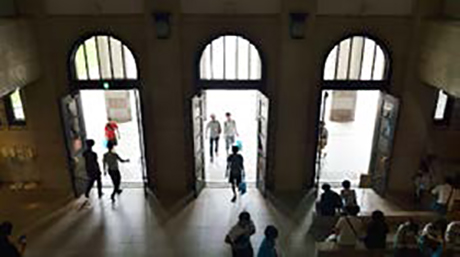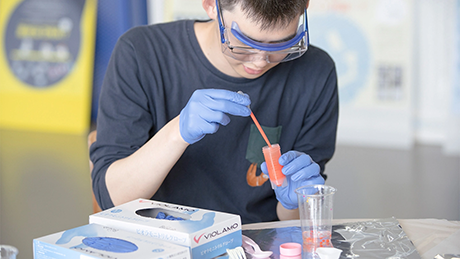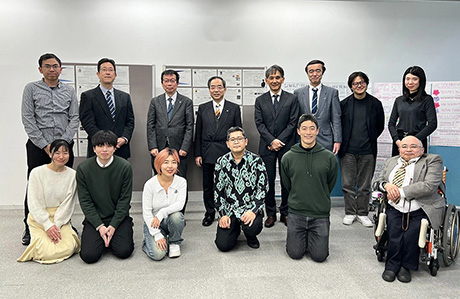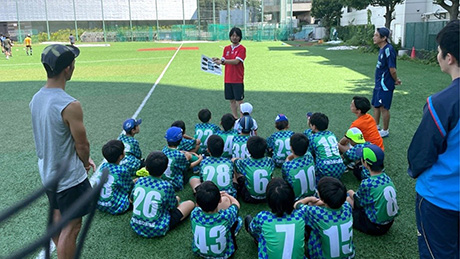Life Science and Technology News
Summer Challenge 2017
Tokyo Tech's 14th education camp for high school students
Since 2004, Tokyo Tech has been offering opportunities for high school students to experience university-level education at the Summer Challenge, a unique three-day-two-night event prepared by Tokyo Tech faculty. By encouraging participants to exercise their creativity and group work skills through seven intellectual challenges, Summer Challenge aims to spark the interest of future Science, Technology and Innovation leaders.
For the past year, Tokyo Tech has been involved in proposing renewals to the admissions procedure for new students. Several universities working together with the Institute on these reforms joined this year's Summer Challenge to witness and share opinions on the activities Tokyo Tech provides to high school students.
Despite initial fears that a typhoon would hamper the start of the event, things kicked off as planned. The next three days were spent sharing diverse ideas, formulating friendships, and pushing the boundaries of curiosity and exploration.
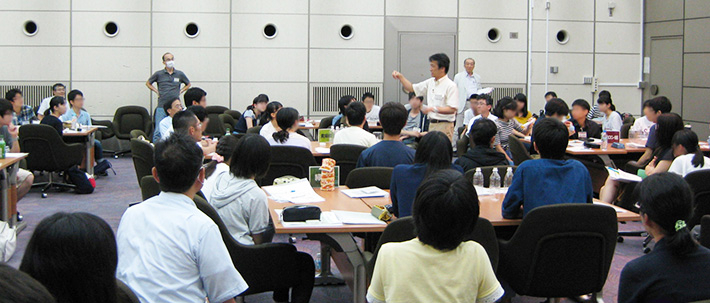
Lesson scenery
Outline of Summer Challenge 2017
- Dates:August 8 to 10, 2017
- Place:National Women's Education Center of Japan in Ranzan Town, Saitama Prefecture
- Number of participating students: 64
Tokyo Tech High School of Science and Technology:35
Ochanomizu University Senior High School: 8
Tokyo Gakugei University Senior High School: 10
Other high schools: 11 - Number of participating staff: 46
Tokyo Tech faculty: 31
High school teachers: 15 (from 9 high schools)
Administrative staff: 9 - Total number of participants:119
Challenge 1: Column land
Professor Kyoko Yamamuro
Department of Industrial Engineering and Economics, School of Engineering
Summer Challenge 2017 kicked off with Column Land, a popular Tokyo Tech class and effective ice-breaker where students evaluate short anonymous pieces of writing prepared in advance by all participants. This year's topic was "wind." Unique stories about electric fans and wind power generation reflected the individual perspectives of the participants, with one short composition describing the feelings of a weather vane taking first prize: "I was only supposed to face forward and advance, but instead the wind swayed me… round and round."
The style is the man himself, according to the proverb. By critiquing each other's writing, students quickly acquainted themselves with others while appreciating different styles and personalities.
High school teacher's comment:
I was impressed by how the students, while submitting their own piece and analyzing 12 other works, were able to understand each other's sensitivity and individuality in such a short time. I will use this activity in my own middle and high school classes in the future.
Challenge 2: Polymers galore: Contemplating the plastic bottle's navel
Professor Takashi Ishizone
Department of Chemical Science and Engineering, School of Materials and Chemical Technology
Polymers. Molecules connected like beautiful necklaces that transform into a slimy liquid when heated, polymers are a diverse bunch that can be utilized in a myriad of ways to make our lives better.
Let us look at this plastic bottle on the table. How is it really made? Is it inflated like a balloon? Does it have seams? Or do we use a mold, like with a waffle iron? It appears to have a navel at the bottom… That must be where the injection begins.
How about Styrofoam? Why is it so light, and why is it not uniform in size when broken down? It seems that it is made of grains that were inflated…?
These were just some of the polymer-related questions that students attempted to answer in the second challenge.
High school teacher's comment:
The topic produced a continuous stream of new ideas from the students.
Challenges 3 and 4: Free research — The feel of the pen
Associate Professor Mitsutoshi Ueda
Professor Kazuo Shinozaki
Department of Materials Science and Engineering, School of Materials and Chemical Technology
"Free research," a marathon challenge stretching over two days, began last year. This year's topic was the feel of the pen.
The task was to analyze and define what factors contribute to the performance of 13 different ballpoint pens using 5 different types of paper. Students were free to experiment in any way they saw fit.
How important are the thickness and weight of the pen? What other factors are important?
Approaches varied. One group measured the pressure put on the pen using a kitchen scale, while another group measured the frictional forces caused by different types of paper.
In addition to getting a feel for the pen, this challenge also included a traditional disassembly task, where students had to take apart an analog kitchen timer, analyze its components, and verify its accuracy. With two missions to tackle, students had to manage their time efficiently and present their findings on the second day.
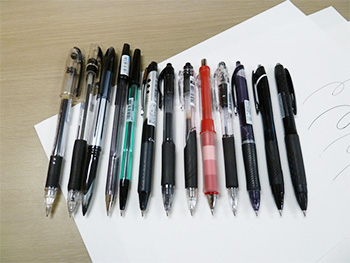
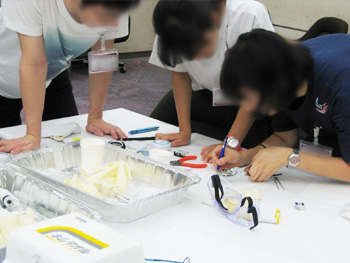
High school teacher's comment:
When examining the pens, many of the groups approached the issue from very different perspectives. Yet they were all able to identify very broad factors related to the performance of these pens and define them logically.
Challenge 5: War of the Currents: AC vs. DC
Professor Koichi Yasuoka
Department of Electrical and Electronic Engineering, School of Engineering
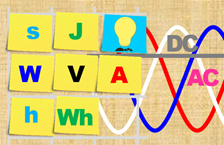
Challenge 5
"You have 3 minutes to list as many electrical units of measurement as you can…Go!" This was the first of several tasks involving the transmission of electricity.
Students then took a trip to the past, measuring the distance over which electricity was transmitted via direct current 130 years ago. The discovery of the alternating current, which came later on the current timeline, allowed the transmission of electricity over long distances. Students were asked to explain the advantages of three-phase alternating current using mathematical expressions.
The use of direct current has been increasing recently, but why? To conclude, groups had to present why they would use either AC or DC when constructing a new house.
Challenge 5 reminded students of how electricity, one of the many things we take for granted, is constantly evolving.
High school teacher's comment:
The debate on which current to use was very interesting. There was no real correct answer, and that allowed students to decide for themselves and justify their answers.
Challenge 6: Molecular architecture — Designing a supramolecule through self-assembly
Professor Masaki Kawano
Department of Chemistry, School of Science
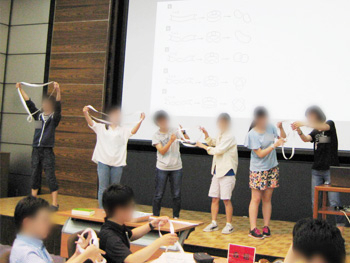
Challenge 6
Challenge 6 began with student discussions on what kinds of structures can be created when molecules with four arms are placed side by side on a surface. What happens when we make these structures three-dimensional?
"Supramolecules line up smoothly using self-assembly. Interesting."
How about if you make large spherical supramolecules? What can these be used for? Pharmaceuticals! Detection devices! The students groups shouted out creative options one after another.
"The world of molecules is truly beautiful, isn't it?" The professor's closing remarks were emotional, and some of the students undoubtedly returned home, cut out long strips of paper, and recreated models of rod-like specimens. These are our future "molecular planners."
High school teacher's comment:
It was great to see both the researcher's philosophy and the topic of ethics being conveyed to the students. This talk was something that I would like all of our school's science students to hear. I think I will have my chemistry club students create molecular structures in the future.
Challenge 7: Controlling information — The sophisticated mechanisms of synapses
Professor Hiroshi Ichinose
Department of Life Science and Technology, School of Life Science and Technology
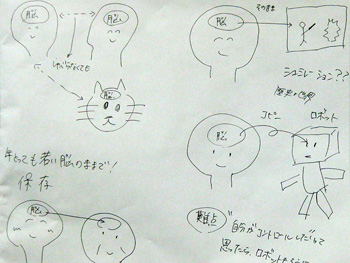
Challenge 7
Why does the sense of taste exist? Are humans able to identify if something is a poison? Perhaps, but how do we transmit that information to ourselves? Is this electrical activity, or is it something chemical? And what are the special characteristics of these means of transmissions? These were the questions students faced in the final challenge.
After learning about the mechanism of transmission through chemical substances, groups were asked to consider what they would like to learn through research on the brain, and to design a research project based on these interests.
Following discussion and debate, the professor urged students to add the question of ethics into the mix. Freedom first, and only then parameters. This challenge aimed to show students how to master the procedure of science.
High school teacher's comment:
I thought it was fantastic how the professor urged the students to heighten their awareness regarding topics such as transporters and degrading enzymes without directly holding their hand!
